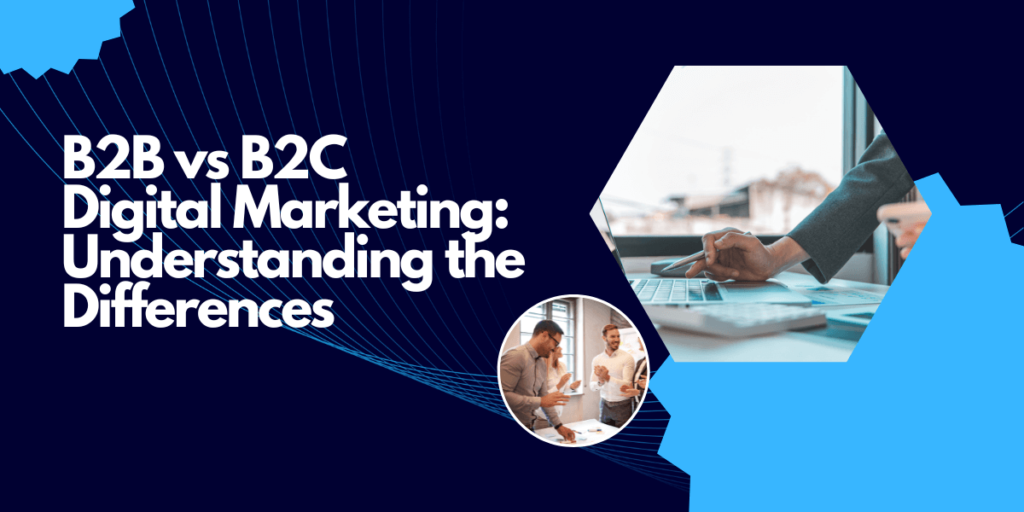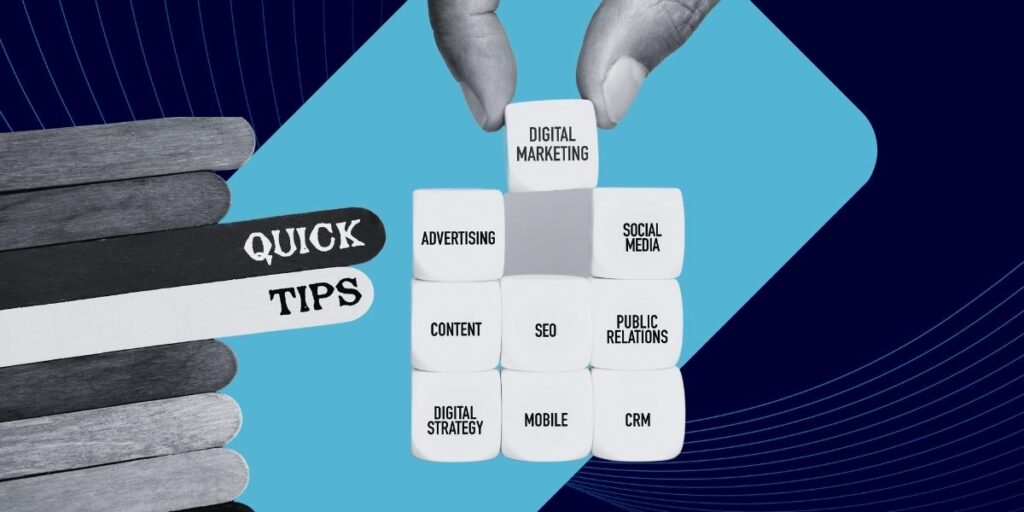In the ever-evolving world of digital marketing, understanding the differences between B2B vs B2C digital marketing strategies is crucial for success. While both aim to increase brand awareness and drive sales, their approaches vary significantly due to distinct target audiences and unique marketing channels.
In this blog post, we will delve into the disparities between B2B and B2C digital marketing, exploring variations in target audience profiles, strategies employed, content creation methods, preferred platforms, sales funnel dynamics, and key performance indicators (KPIs). Let’s dive in!
Understanding B2B and B2C Digital Marketing
B2B and B2C digital marketing are two distinct approaches used to target different audiences. B2B marketing focuses on promoting products or services to businesses, while B2C marketing targets individual consumers.
In B2B marketing, the emphasis is on building relationships with other companies by showcasing expertise and providing solutions tailored to their specific needs. Conversely, in B2C marketing, the focus shifts towards influencing individual purchasing decisions through emotional appeals and creating a personal connection with the consumer. Understanding these differences is crucial for developing effective digital marketing strategies that resonate with the intended audience.
What is B2B Digital Marketing?
B2B digital marketing is a targeted approach to reaching specific audiences. By focusing on individual businesses instead of the general public, B2B marketers can tailor their messages and strategies to meet the unique needs and preferences of these clients. This allows for more effective lead generation and building long-term relationships with businesses.
Key points for B2B digital marketing:
- Targeting a specific audience
- Building long-term relationships with clients
- Focusing on lead generation
What is B2C Digital Marketing?
Appealing to a broader consumer base is at the core of B2C digital marketing. By understanding the individual needs and preferences of customers, marketers can tailor their strategies to effectively reach a larger audience and drive sales.
Creating emotional connections with customers further enhances the effectiveness of B2C digital marketing, as it fosters loyalty and brand advocacy. Additionally, driving immediate sales is another key objective in this form of marketing, utilizing various tactics such as targeted promotions and personalized offers to capture customer interest and convert them into paying customers.
Differences in Target Audience
Let’s now see the B2B vs B2C target audience differences.
B2B Target Audience
Niche industries and professionals are a key target audience in B2B marketing. By focusing on specific sectors, such as healthcare or technology, businesses can tailor their messaging to address the unique needs and challenges of these industries. This helps establish credibility and build trust with potential clients.
Decision makers and stakeholders play a crucial role in B2B purchasing decisions. These individuals have the authority to approve or reject proposals, making it essential to engage them effectively. Understanding their pain points and providing solutions that align with their objectives is vital for successful B2B marketing strategies.
Unlike B2C sales cycles that are often short-lived, B2B sales cycles tend to be longer due to more complex decision-making processes involving multiple stakeholders. Patience is required as relationships need time to develop before closing deals. Building strong connections through personalized communication channels can help nurture leads throughout this extended journey toward conversion.
B2C Target Audience
The mass market consumer base is a key characteristic of the B2C target audience. These are individuals and households who make up a large portion of the market and have diverse needs and preferences. They are looking for products or services that cater to their everyday needs, making them an important focus for B2C digital marketing.
The shorter buying process is another notable aspect when targeting the B2C audience. Unlike B2B transactions that often involve multiple decision-makers and lengthy procurement procedures, individual consumers tend to have a more streamlined purchasing journey.
This means that B2C marketers need to capture their attention quickly, provide relevant information, and facilitate easy online transactions to maximize conversions in this fast-paced environment.
Differences in Marketing Strategies
B2B vs B2C marketing strategy differences:
B2B Marketing Strategies
- Lead Generation and Sales Funnel: In B2B marketing, lead generation plays a crucial role in driving sales. By implementing effective lead-generation strategies, businesses can attract potential clients and guide them through the sales funnel. This involves identifying target customers, creating compelling content to capture their interest, nurturing leads with personalized communication, and ultimately converting them into paying customers.
- Account-Based Marketing: Account-based marketing (ABM) is a strategic approach that focuses on targeting specific accounts rather than mass audiences. It enables businesses to customize their marketing efforts according to the needs of individual companies or decision-makers. Through ABM, organizations can build strong relationships with key accounts by delivering personalized messaging and tailor-made solutions.
- Content Marketing for Thought Leadership: A successful B2B marketing strategy often includes thought leadership through content marketing. By consistently producing high-quality and informative content such as articles, whitepapers, videos or webinars relevant to their industry or niche, businesses can establish themselves as experts in their field. This not only enhances brand credibility but also attracts potential clients who are seeking valuable insights and expertise.
B2C Marketing Strategies
Mass advertising and brand awareness are crucial components of B2C marketing strategies. By reaching a wide audience through channels such as television, radio, and billboards, businesses can create a strong brand presence in the minds of consumers. This helps to increase recognition and recall when it comes time for customers to make purchasing decisions.
Social media influencer campaigns have become increasingly popular in B2C marketing strategies. By partnering with influencers who have large followings on platforms like Instagram and YouTube, businesses can leverage their influence to promote products or services directly to their target market. This approach allows for more authentic and personalized customer engagement, as consumers trust recommendations from people they admire.
In addition to mass advertising and influencer campaigns, personalized customer engagement is vital in B2C marketing strategies. Tailoring messages and experiences based on individual preferences helps build stronger relationships with customers. Whether it’s through targeted email campaigns or customized product recommendations, personalization creates a sense of value that fosters loyalty among consumers.
By incorporating these key elements into their B2C marketing strategies – mass advertising for brand awareness, social media influencer campaigns for authenticity, and personalized customer engagement – businesses can effectively connect with their target audience in today’s digital landscape.
Differences in Content Creation
B2B content creation focuses on providing in-depth information, industry insights, and case studies to educate and inform businesses. It aims to establish credibility and build trust with a professional audience. On the other hand, B2C content creation is geared towards capturing attention quickly and creating an emotional connection with consumers. It emphasizes visual appeal, storytelling, and creating engaging experiences to drive interest in products or services.
In B2B content creation, it is crucial to understand the target audience’s pain points, and challenges they face within their industry, and provide solutions that address those issues. Content should be informative, data-driven, and authoritative to position the brand as a thought leader in the field.
Conversely, B2C content creation requires a deep understanding of consumer behavior patterns and preferences. The focus is on generating excitement around products or services by highlighting benefits that resonate with consumers’ desires or aspirations. Visual elements such as images or videos can play a significant role in capturing attention quickly.
The differences between B2B and B2C digital marketing extend beyond just the type of content created; it also influences distribution channels used (e.g., LinkedIn for B2B versus Instagram for B2C) as well as tone of voice (formal versus conversational). Understanding these distinctions allows marketers to tailor their strategies effectively based on their target audience’s specific needs and expectations
B2B Content Creation
In-depth industry analysis offers valuable insights into the specific challenges and trends within a B2B market, allowing businesses to create content that directly addresses their target audience’s pain points.
Expert interviews and case studies provide real-world examples of successful strategies and highlight the expertise of industry leaders, establishing credibility and trust with potential clients. Educational whitepapers and e-books offer comprehensive information on complex topics, positioning businesses as thought leaders in their field while providing tangible value to prospects.
B2C Content Creation
Engaging social media campaigns is a powerful tool in B2C content creation, allowing businesses to connect with their target audience on platforms like Facebook, Instagram, and Twitter. These campaigns can include creative and interactive elements such as polls, challenges, or user-generated content to encourage engagement and build brand loyalty.
Compelling storytelling through videos is another effective strategy for B2C content creation. Videos have the ability to capture attention and evoke emotions in a way that text alone cannot. By creating compelling narratives that resonate with their target audience, businesses can effectively communicate their brand story and values.
Interactive quizzes and contests provide an opportunity for businesses to engage with consumers while also collecting valuable data. Offering quizzes or running contests not only creates excitement but also allows companies to gather insights into consumer preferences and behavior patterns.
- Engaging in social media campaigns
- Compelling storytelling through videos
- Interactive quizzes and contests
Differences in Channels and Platforms
B2B vs B2C digital marketing strategies differ significantly in their choice of channels and platforms. For B2B marketing, LinkedIn is a primary platform due to its professional focus and networking capabilities. Email marketing also plays a crucial role in reaching out to business professionals directly.
On the other hand, B2C marketers prioritize social media platforms like Facebook and Instagram for their wide reach and potential for viral content. Additionally, influencer partnerships are commonly utilized in B2C campaigns to tap into popular consumer trends.
Despite having some overlap, the channels and platforms used in B2B and B2C digital marketing reflect their distinct target audiences’ preferences and behaviors. Understanding these differences is essential to effectively tailor marketing efforts towards specific business or consumer needs, ultimately maximizing engagement, conversion rates, and ROI.
a. B2B Channels and Platforms
LinkedIn is the go-to platform for B2B networking, allowing professionals to connect with decision-makers and establish valuable connections. Its business-focused approach makes it an ideal channel for building relationships and generating leads within the B2B space.
Email marketing remains a powerful tool in reaching decision-makers directly. By crafting personalized messages tailored to their needs, businesses can effectively communicate their value proposition and convert prospects into customers.
Industry-specific forums and communities provide niche targeting opportunities for B2B audiences. Engaging in these platforms allows businesses to connect with like-minded individuals, share insights, and establish themselves as thought leaders within their respective industries.
b. B2C Channels and Platforms
Social media platforms like Facebook, Instagram, and Twitter offer a wide reach for consumer engagement. These platforms allow businesses to connect with their target audience on a personal level and create awareness about their products or services.
Utilizing influencer marketing is another effective strategy in B2C digital marketing, where popular individuals are leveraged to promote products/services. This helps build trust among consumers and increase brand visibility. E-commerce websites and marketplaces provide a direct selling channel to consumers, allowing businesses to showcase their offerings and facilitate easy transactions.
Differences in Sales Funnel
B2B vs B2C digital marketing strategies differ significantly when it comes to the sales funnel. In B2B, the sales cycle tends to be longer and more complex, involving multiple decision-makers who prioritize factors such as ROI and long-term benefits.
B2B Sales Funnel
In B2B sales, the cycle is often longer due to more complex decision-making processes. Multiple stakeholders are involved, requiring a strategic approach to address their diverse needs and priorities. Therefore, focusing on lead nurturing becomes crucial in building relationships and guiding prospects through each stage of the funnel.
B2C Sales Funnel
Shorter sales cycles are a key feature of the B2C sales funnel. With individual consumers as the decision-makers, there is less bureaucratic red tape to navigate, resulting in quicker purchasing decisions. In this fast-paced environment, it’s crucial for businesses to focus on immediate conversions rather than long-term relationship building.
Overall these differences highlight how understanding your target audience can shape your approach within each type of market: business-to-business (B2B) versus business-to-consumer (B2C). By recognizing these disparities early on companies can better optimize their resources towards engaging with potential buyers effectively at every stage of their respective customer journeys – ultimately driving higher conversion rates for themselves while also providing quality experiences customers want from brands today
Differences in Key Performance Indicators (KPIs)
The KPIs are crucial for tracking the success of nurturing leads through the sales funnel.
B2B and B2C digital marketing strategies have distinct key performance indicators (KPIs) that businesses should focus on to measure their success. Understanding these differences is crucial for businesses to align their goals and achieve optimal results within their respective target markets.
By understanding these differences in KPIs between B2B and B2C digital marketing strategies, businesses can align their goals more effectively to achieve optimal results within their respective target markets.
B2B KPIs
Lead generation, conversion rate, and customer lifetime value are key performance indicators (KPIs) that businesses should focus on to measure their B2B digital marketing success. These metrics provide valuable insights into the effectiveness of marketing strategies and the overall health of a business’s sales funnel.
- Lead Generation: Number of qualified leads generated from various digital marketing channels
- Conversion Rate: Percentage of leads that convert into customers
- Customer Lifetime Value: The total revenue generated by a customer over their entire relationship with the business
B2C KPIs
Website Traffic, Click-through Rate (CTR), and Return on Ad Spend (ROAS) are key performance indicators (KPIs) that businesses should closely monitor in B2C digital marketing. Website traffic measures the number of visitors to a website, indicating its popularity and potential for conversions. CTR reflects the effectiveness of ads by measuring the percentage of users who click on them after viewing. ROAS evaluates the profitability of advertising campaigns by comparing the revenue generated with the amount spent on ads. Monitoring these KPIs allows businesses to optimize their strategies and drive better results in B2C digital marketing efforts.
B2B and B2C digital marketing strategies have distinct key performance indicators (KPIs) that businesses should focus on to measure their success. Understanding these differences is crucial for businesses to align their goals and achieve optimal results within their respective target markets.
In B2B digital marketing, key KPIs include lead generation, conversion rate, and customer lifetime value. Lead generation refers to the number of qualified leads generated from various digital marketing channels. This metric provides insights into the effectiveness of marketing strategies in attracting potential business clients. A high number of qualified leads indicates that the marketing efforts are effectively capturing the attention of target customers.
Conversion rate is another important KPI in B2B digital marketing. It measures the percentage of leads that convert into customers. A high conversion rate shows that the marketing strategies are successfully nurturing leads through the sales funnel and turning them into paying customers. Businesses should aim to continuously improve their conversion rate to maximize their revenue opportunities.
Customer lifetime value is a KPI that reflects the total revenue generated by a customer over their entire relationship with the business. This metric helps businesses understand the long-term value of their customers and the effectiveness of their customer retention strategies. By optimizing customer lifetime value, businesses can drive brand loyalty and maximize their revenue potential.
On the other hand, B2C digital marketing places greater emphasis on customer engagement and retention metrics. Key KPIs in this strategy include website traffic, click-through rate (CTR), and return on ad spend (ROAS).
Website traffic refers to the number of visitors who come to a website. This metric is important as it indicates the reach and visibility of the business’s digital marketing efforts. Increasing website traffic can lead to more opportunities for customer engagement and conversions.
Click-through rate (CTR) measures the percentage of people who click on a specific link or advertisement compared to the total number of impressions. A high CTR indicates that the marketing messages and advertisements are compelling and engaging to the target audience. Businesses should aim to continuously improve their CTR to increase the effectiveness of their digital marketing campaigns.
Return on ad spend (ROAS) is a metric that measures the revenue generated from advertising compared to the amount spent on ads. It provides insights into the profitability and efficiency of advertising campaigns. A high ROAS indicates that the advertising efforts are generating a positive return on investment. By monitoring ROAS, businesses can optimize their advertising strategies to drive better results and maximize their revenue.
By understanding these differences in KPIs between B2B and B2C digital marketing strategies, businesses can align their goals more effectively to achieve optimal results within their respective target markets.
Conclusion
In conclusion, B2B and B2C digital marketing strategies have different KPIs that businesses should focus on to measure their success. By understanding these differences and monitoring the relevant metrics, businesses can optimize their strategies and drive better results in their digital marketing efforts. Whether it’s lead generation and conversion rate in B2B marketing or website traffic and ROAS in B2C marketing, businesses can align their goals and achieve optimal results within their respective target markets.
At The Marketing Hawks, we specialize in helping businesses develop and implement effective digital marketing strategies. With our expertise and attention to detail, we can help you identify the most important KPIs for your business and create a customized plan to maximize your revenue potential.
Whether you need assistance with lead generation and conversion rate in B2B marketing or increasing website traffic and return on ad spend in B2C marketing, our team of professionals is dedicated to providing you with the tools and strategies you need to succeed.
Contact us today to learn more about how The Marketing Hawks can help your business thrive in the digital marketing landscape.





